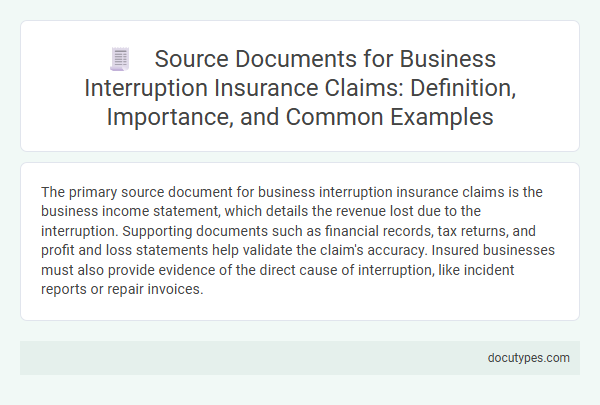The primary source document for business interruption insurance claims is the business income statement, which details the revenue lost due to the interruption. Supporting documents such as financial records, tax returns, and profit and loss statements help validate the claim's accuracy. Insured businesses must also provide evidence of the direct cause of interruption, like incident reports or repair invoices.
Introduction to Source Documents in Business Interruption Insurance
Business interruption insurance claims require accurate and detailed source documents to validate losses and ensure proper compensation. These documents serve as the foundation for assessing the financial impact of an interruption on a business.
- Definition of Source Documents - Source documents include all original records that provide evidence of business income and expenses before and during the interruption period.
- Types of Source Documents - Common source documents consist of financial statements, tax returns, sales records, and inventory reports relevant to the claim.
- Role in Claims Process - These documents enable insurers to verify the extent of business interruption losses and calculate the indemnity payable under the insurance policy.
Defining Source Documents for Insurance Claims
Source documents for business interruption insurance claims are original records that verify the loss experienced by a business due to covered disruptions. These documents provide concrete evidence of financial impact and operational downtime.
Common source documents include financial statements, sales records, and inventory reports that demonstrate revenue loss during the interruption period. Insurers rely on these documents to validate the claim and calculate the appropriate compensation.
Importance of Accurate Source Documentation
The source document for business interruption insurance claims is typically the detailed financial records that show loss of income directly resulting from the insured event. Accurate source documentation is crucial because it provides verifiable evidence supporting the claim, ensuring a smoother and faster settlement process. You must maintain precise and comprehensive records to maximize the chances of a successful claim outcome.
Role of Source Documents in Business Interruption Claims Processing
Source documents are essential for validating business interruption insurance claims by providing concrete evidence of financial losses and the cause of interruption. These documents include financial statements, sales records, and proof of property damage, which collectively support the claim's accuracy. Insurers rely on these documents to assess the extent of loss and to determine appropriate compensation.
Common Types of Source Documents Required
Source documents for business interruption insurance claims are essential for verifying the financial impact of an insured event. These documents provide evidence of lost income and expenses incurred during the interruption period.
- Financial Statements - Detailed profit and loss statements demonstrate revenue before and after the interruption.
- Tax Returns - Tax documents validate reported income and help quantify losses accurately.
- Sales Records - Invoices and sales reports confirm the scale and duration of business disruption.
Accurate source documents streamline the claims process and support fair compensation for business interruption losses.
Financial Statements as Key Evidence
Business interruption insurance claims rely heavily on accurate documentation to validate losses. The primary source document is your financial statements, which provide critical evidence of income before and after the disruption.
Financial statements, including profit and loss accounts, balance sheets, and cash flow statements, demonstrate the ongoing business performance and quantify the revenue impact. Insurers assess these documents to establish the baseline income and measure the extent of financial loss caused by the interruption. Maintaining detailed and up-to-date financial records strengthens your claim's credibility and expedites the review process.
Sales Records and Invoices in Claim Validation
Sales records and invoices serve as critical source documents for business interruption insurance claims. They provide concrete proof of revenue and operational activity before the interruption occurred.
These documents help insurers validate the financial impact by comparing normal sales levels to the period of business disruption. Accurate sales records and detailed invoices ensure a fair and precise claim assessment.
Payroll Records and Employment Documentation
| Source Document | Description | Importance for Business Interruption Insurance Claims |
|---|---|---|
| Payroll Records | Detailed logs of employee wages, hours worked, and pay periods. | Essential for verifying ongoing payroll expenses during the interruption period. Supports claim validation by confirming salary continuity and employee count. |
| Employment Documentation | Contracts, employment agreements, and personnel files outlining job roles and durations. | Helps substantiate employee status and contractual obligations. Critical for proving payroll liabilities and workforce maintenance amid business disruption. |
Supporting Documents for Extra Expenses
What is the source document for business interruption insurance claims related to extra expenses? The primary source document is the detailed invoice or receipt that itemizes the extra costs incurred during the interruption period. These supporting documents verify the validity and necessity of your additional expenses for claim processing.
What Is the Source Document for Business Interruption Insurance Claims? Infographic

